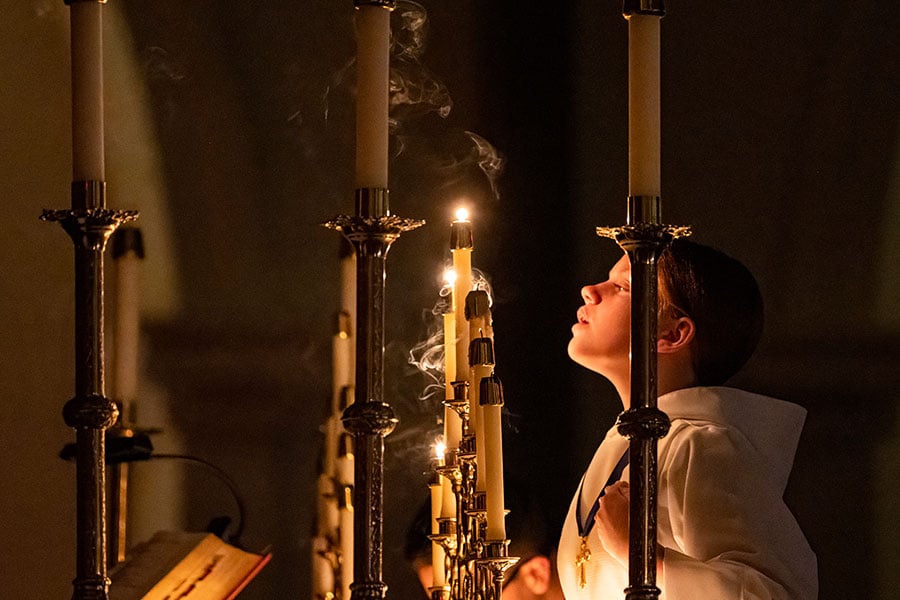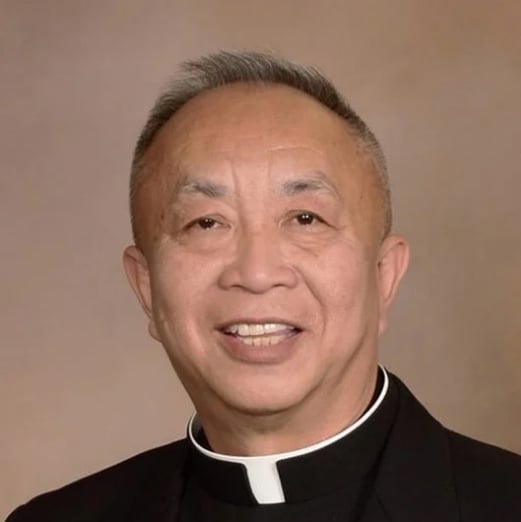Seven functions of laity

Altar server Helene Long helps at the candlelight Rorate Mass, at St. Philip the Apostle Church, Dec. 9, 2023. (NTC/Juan Guajardo)
In his last column, Father Thu Nguyen, pastor of St. Paul the Apostle Parish in Fort Worth and diocesan director of liturgy and worship, explained that lay ministers are called to assist with the celebration of Mass.
In this column, he goes deeper into the responsibilities of some of those special roles.
Why did you choose this topic for the column?
Fr. Nguyen: In visiting parishes around the diocese to celebrate Mass and to conduct liturgical workshops, a lot of different practices by lay liturgical ministers have surfaced, and many of them are not conformed to the guidelines of the General Instruction of the Roman Missal as well as the USCCB guidelines.
Ecclesial ministers have a privilege to serve according to the function of their role, but they must undergo training to maintain the sacredness of the celebration.
Remind us how the laity serve in the celebration of Holy Mass.
Fr. Nguyen: We commonly see seven special functions performed by laity designated in the GIRM: reader, altar server, sacristan, cantors and musicians, extraordinary ministers of holy Communion, hospitality ministers, and ornamentors of the Church.

What is an “ornamentor of the Church”?
Fr. Nguyen: We use that terminology because in the sanctuary, we give prominence to the altar, the ambo, and the presider’s chair. When people are decorating for a specific church season, we need to emphasize those three elements. We want to make them more visible and beautiful, not detract from them or direct attention to a beautiful flower arrangement that diminishes the essential elements of the sanctuary.
People have good intentions, but they might not know the primary priority when they decorate.
Ornamentation should be noble and simple and real. We don’t use artificial flowers, because the Mass is a sacrificial offering — the sacrifice of Christ for us, and our sacrificial offering too. A real flower being sacrificed to decorate the church adds to the meaning.
Is there a difference between a sacristan and an acolyte?
Fr. Nguyen: There’s a little bit of overlap. The sacristan is the person who prepares elements used for the celebration of Mass, like the paten, chalice, washing bowl, and all that. They also make certain a lectionary is in place for the readers and a songbook and Roman Missal at the presider’s location.
The sacristan also tends the clergy’s vestments according to the appropriate color for the liturgical season.
A sacristan also oversees other liturgical ministers, especially the extraordinary ministers of holy Communion. If a fall or spill occurs, the sacristan is the person who responds immediately.
An acolyte can do those tasks, but also prepares the altar and assists in many ways near the sanctuary, including purifying the vessels according to GIRM guidelines. In the Diocese of Fort Worth, men in formation for the permanent diaconate or priesthood are instituted as acolytes by Bishop Michael Olson.
The acolyte assists the priest and the deacon, if present.
Is a lector the same as a reader?
Fr. Nguyen: Like an acolyte, the bishop institutes men in formation as lectors.
A reader is very important — I call them proclaimers because they proclaim the Word of God to the assembly during the Liturgy of the Word. God speaks to His people through the reader. They must be prepared; they must speak with clarity and have good pronunciation and communication skills. They must study the Word before they begin.
What are the functions of greeters and ushers?
Fr. Nguyen: Prior to Pope St. Paul VI’s 1972 motu proprio which expanded the role of laity in the celebration of Mass, a man who began priestly formation served as a porter, a minor order. He was responsible for receiving people and guarding the church door and the people inside.
Greeters and ushers flow from this role, but the terminology I prefer is ministers of hospitality. Why? Because of Abraham’s story, how he received the messengers from God and provided hospitality to them.
Hospitality ministers need training on all the functions — greeting the people, directing people to be seated, collecting money, and helping create a safe environment. This ministry affects other ministries and it’s very complex.
What are some guidelines for extraordinary ministers of holy Communion?
Fr. Nguyen: The ministry of the Eucharist is reserved for bishops, priests, and deacons — they are the ordinary ministers of holy Communion.
An extraordinary minister of holy Communion can be commissioned by the pastor if there are not sufficient ordinary ministers.
The extraordinary ministers of holy Communion only approach the altar after the priest has received the precious Blood. When they come up to assist the priest, they are given Communion. They don’t take the chalice or ciborium; it is handed to them.
When they are distributing Communion, the formula is, “The Body of Christ” or “The Blood of Christ.” Nothing more. That’s the reality.
All of Fr. Nguyen’s columns are available at NorthTexasCatholic.org/understanding-the-mystery.
